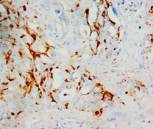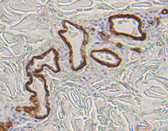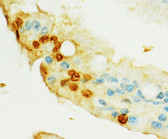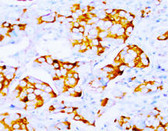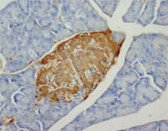 Loading... Please wait...
Loading... Please wait...- Call us on 443-686-9618
- Wish Lists
- My Account
- 0.00
Categories
- Home
- IHC Antibodies
- HIF-1 alpha IHC Antibody
HIF-1 alpha IHC Antibody
Product Description
Description |
HIF-1α (Hypoxia-inducible factor 1α,HIF1A) is a transcription factor that mediates cellular and systemic homeostatic responses to reduced O2 availability in mammals, including angiogenesis, erythropoiesis and glycolysis. This gene was mapped to 14q21-q24. HIF-1α transactivate genes required for energy metabolism and tissue perfusion and is necessary for embryonic development and tumor explant growth. HIF-1alpha is over expressed during carcinogenesis, myocardial infarction and wound healing. It is crucial for the cellular response to hypoxia and is frequently over expressed in human cancers, resulting in the activation of genes essential for cell survival. HIF-1α regulates the survival and function in the inflammatory microenvironment directly. It is a transcription factor that plays a pivotal role in cellular adaptation to changes in oxygen availability.
|
Catalog Number
|
IW-PA1041 |
Quantity
|
9 ml |
|
Host
|
Rabbit
|
|
Clone
|
Polyclonal
|
|
Isotype
|
IgG
|
|
Immunogen
|
A synthetic peptide corresponding to a sequence mapping at the C-terminal of human HIF-1α, identical to the related rat and mouse sequence.
|
|
Purity
|
Immunogen affinity purified
|
|
Conjugate
|
Unconjugated
|
|
Species Reactivity
|
Human, mouse, rat. Not tested in other species.
|
|
Positive Control
|
Skin, hypoxia induced tissues, mammary cancer tissues
|
|
Cellular Localization
|
Cytoplasmic in normoxia, nuclear in hypoxia.
|
|
Form
|
Ready to use solution in PBS with stabilizer and 0.01% sodium azide. No further dilution needed. Serum blocking step should be omitted.
|
|
Storage
|
Store at 2-8 °C. Do not freeze.
|
|
Applications
|
IHC-P: Heat induced epitope retrieval is required for formalin fixed paraffin sections. IHC-Tek Epitope Retrieval Solution (Cat# IW-1100) is recommended. IHC-Fr: Not tested. ICC: Not tested.
|
|
Limitations
|
This product is intended for Research Use Only. Interpretation of the test results is solely the responsibility of the user.
|
|
Precautions
|
Users should follow general laboratory precautions when handling this product. Wear personal protective equipment to avoid contact with skin and eyes.
|
|
References
|
1. Sutter, C. H.; Laughner, E.; Semenza, G. L. : Hypoxia-inducible factor 1-alpha protein expression is controlled by oxygen-regulated ubiquitination that is disrupted by deletions and missense mutations. Proc. Nat. Acad. Sci. 97: 4748-4753, 2000. 2. Elson, D. A.; Thurston, G.; Huang, L. E.; Ginzinger, D. G.; McDonald, D. M.; Johnson, R. S.; Arbeit, J. M. : Induction of hypervascularity without leakage or inflammation in transgenic mice overexpressing hypoxia-inducible factor-1-alpha. Genes Dev. 15: 2520-2532, 2001. 3. Koshiji, M.; To, K. K.-W.; Hammer, S.; Kumamoto, K.; Harris, A. L.; Modrich, P.; Huang, L. E. : HIF-1-alpha induces genetic instability by transcriptionally downregulating MutS-alpha expression. Molec. Cell 17: 793-803, 2005. 4. Ivan, M.; Kondo, K.; Yang, H.; Kim, W.; Valiando, J.; Ohh, M.; Salic, A.; Asara, J. M.; Lane, W. S.; Kaelin, W. G., Jr. : HIF-alpha targeted for VHL-mediated destruction by proline hydroxylation: implications for O(2) sensing. Science 292: 464-468, 2001.
|

